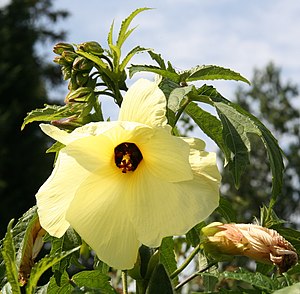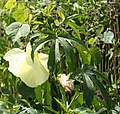Cassava muskrat
| Cassava muskrat | ||||||||||||
|---|---|---|---|---|---|---|---|---|---|---|---|---|

Cassava muskrat ( Abelmoschus manihot ) |
||||||||||||
| Systematics | ||||||||||||
|
||||||||||||
| Scientific name | ||||||||||||
| Abelmoschus manihot | ||||||||||||
| ( L. ) Medic. |
Cassava abelmoschus ( Abelmoschus manihot , Syn. : Hibiscus manihot ) is a plant type from the family of the Malvaceae . She comes from East Asia and is used in India for a long time as a crop grown. The species name refers to the similar habitus manioc ( Manihot esculenta ). In Europe, plants of this species first flowered in England in 1712.
description
The shrub reaches heights of growth of up to 2.50 meters. It forms hand-shaped, five- to nine-fold, fingered leaves. The edge of the leaves is roughly serrated. The yellow flowers have a dark purple spot in the middle and are 10 to 20 centimeters wide. The 4 to 6 (rarely up to 8) outer sepals are 15 to 25 (rarely up to 30) millimeters long and ovate to oblong. The fruits are egg-shaped to elongated, stiff-haired and 4 to 8 inches long.
The flowering period extends from July to September.
The number of chromosomes is 2n = 130, less often 40.
Occurrence
Manioc muskrat occurs in Southeast Asia on river banks and in broad-leaved forests at altitudes of 600 to 1800 meters.
Systematics
Several subspecies and varieties can be distinguished:
- Abelmoschus manihot (L.) Medic. subsp. manihot : It occurs in culture.
-
Abelmoschus manihot (L.) Medic. subsp. tetraphyllus (Roxb. ex Hornem.) Borss. Waalk. : With several varieties including:
- Abelmoschus manihot (L.) Medic. subsp. tetraphyllus (Roxb. ex Hornem.) Borss. Waalk. var. megaspermus Hemadri : It occurs in India.
- Abelmoschus manihot (L.) Medic. subsp. tetraphyllus (Roxb. ex Hornem.) Borss. Waalk. var. pungens (Roxb.) Hochr. : It occurs in Pakistan, India, Bhutan, Nepal, Thailand, Myanmar, Indonesia, Malaysia, the Philippines, China and Taiwan.
- Abelmoschus manihot (L.) Medic. subsp. tetraphyllus (Roxb. ex Hornem.) Borss. Waalk. var. tetraphyllus (Roxb. ex Hornem.) Hochr. : It occurs in India, Indonesia, the Philippines and Papua New Guinea.
use
In Central Europe, the cassava muskrat is rarely used as an ornamental plant for summer borders. In East and Southeast Asia, the species is grown as a vegetable, fiber and medicinal plant. It is cultivated as an annual.
swell
- Christian Grunert: Garden flowers from A to Z . 6th edition. Neumann Verlag, Leipzig Radebeul 1984.
- Eckehart J. Jäger, Friedrich Ebel, Peter Hanelt, Gerd K. Müller (eds.): Rothmaler excursion flora from Germany. Volume 5: Herbaceous ornamental and useful plants . Spectrum Academic Publishing House, Berlin Heidelberg 2008, ISBN 978-3-8274-0918-8 .
Individual evidence
- ↑ Abelmoschus manihot at Tropicos.org. In: IPCN Chromosome Reports . Missouri Botanical Garden, St. Louis
- ↑ a b c d e Abelmoschus in the Germplasm Resources Information Network (GRIN), USDA , ARS , National Genetic Resources Program. National Germplasm Resources Laboratory, Beltsville, Maryland. Retrieved June 17, 2017.


